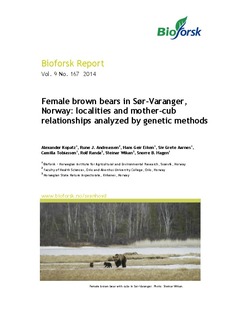| dc.contributor.author | Kopatz, Alexander | |
| dc.contributor.author | Andreassen, Rune | |
| dc.contributor.author | Eiken, Hans Geir | |
| dc.contributor.author | Aarnes, Siv | |
| dc.contributor.author | Tobiassen, Camilla | |
| dc.contributor.author | Randa, Rolf | |
| dc.contributor.author | Wikan, Steinar | |
| dc.contributor.author | Hagen, Snorre | |
| dc.coverage.spatial | Norge, Finnmark, Sør-Varanger, Øvre Pasvik | nb_NO |
| dc.date.accessioned | 2017-08-22T13:33:46Z | |
| dc.date.available | 2017-08-22T13:33:46Z | |
| dc.date.created | 2015-03-04T12:13:18Z | |
| dc.date.issued | 2014-12-10 | |
| dc.identifier.isbn | 978-82-17-01363-1 | |
| dc.identifier.uri | http://hdl.handle.net/11250/2451524 | |
| dc.description.abstract | Knowledge on the number of female brown bears, especially reproducing females, is important for the wildlife management. One of the largest and densest populations of brown bears in Norway is located in Sør-Varanger, Finnmark, Northern Norway. Observations of females with cubs are reported regularly in the region. Information on the relatedness among individuals is often unknown as well as specifics on the number of reproductions and relatedness among females within this population. We have utilized genetic data originating from feces and hair samples collected in Sør-Varanger in the years 2004-2014 to investigate female brown bear localities. In the same period, personnel from the Norwegian State Nature Inspectorate (SNO) have observed 9 female brown bears with potential female cubs (a priori probability of 0.5). Sampling areas of those female brown bears and their potential offspring showed substantial geographical vicinity suggesting overlapping home ranges. We then calculated the likelihood ratios for these relationships using the forensic software Familias for 18-mother-female cub relationships. For 10 of 18 such relationships, the genetic relationship between mother and female cub were confirmed as their observation in the field was suggestive of. Of the initially observed 9 female bears, 6 have produced 10 female cubs, which here could be confirmed by genetic methods. The remaining 3 females were not excluded to be mothers to their potential cubs, but these relationships cannot be confirmed without additional DNA analyses. Another family relationship could also be confirmed between two observed female bears, but the type of relationship could not be determined. | nb_NO |
| dc.language.iso | eng | nb_NO |
| dc.publisher | Bioforsk | nb_NO |
| dc.relation.ispartof | Bioforsk Rapport | |
| dc.relation.ispartofseries | Bioforsk rapport;9(167) 2014 | |
| dc.subject | Molekylær økologi | nb_NO |
| dc.subject | Molecular ecology | nb_NO |
| dc.subject | DNA | nb_NO |
| dc.subject | Slektskap | nb_NO |
| dc.subject | Kinship | nb_NO |
| dc.subject | Brunbjørn | nb_NO |
| dc.subject | Brown bear | nb_NO |
| dc.title | Female brown bears in Sør-Varanger, Norway: localities and mother-cub relationships analyzed by genetic methods | nb_NO |
| dc.type | Research report | nb_NO |
| dc.description.version | publishedVersion | nb_NO |
| dc.subject.nsi | VDP::Naturressursforvaltning: 914 | nb_NO |
| dc.subject.nsi | VDP::Natural resource management: 914 | nb_NO |
| dc.source.pagenumber | 25 | nb_NO |
| dc.source.volume | 9 | nb_NO |
| dc.source.issue | 167 | nb_NO |
| dc.identifier.cristin | 1229356 | |
| dc.relation.project | Bioforsk: 8831 | nb_NO |
| cristin.ispublished | true | |
| cristin.fulltext | original | |
